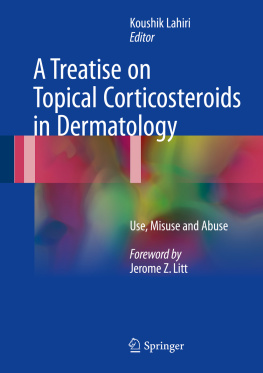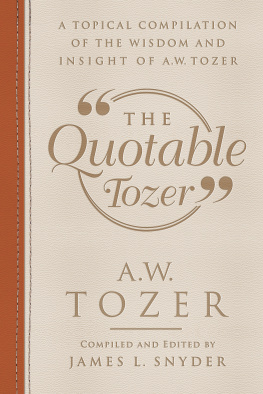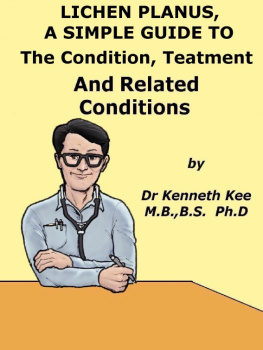Springer Nature Singapore Pte Ltd. 2018
Koushik Lahiri (ed.) A Treatise on Topical Corticosteroids in Dermatology
1. Evolution and Development of Topical Corticosteroids
Abstract
Corticosteroids are the steroidal compounds derived from the adrenal gland or prepared synthetically. Topical corticosteroids are mainly glucocorticoids. The first use of corticosteroids was in the form of adrenal extracts which was reported in 1930 by Swingle et al. In the same year, Tadeus Reichstein in Zurich; Edward Kendall at the Mayo Clinic, USA; and Oskar Wintersteiner at Columbia had been able to isolate small amount of active steroid from the adrenal gland. Systemically it was used successfully to treat rheumatoid arthritis in 1948. Reichstein, Kendall and Hench received a Nobel Prize for their work with adrenal steroids. The first successful use of topical hydrocortisone in human dermatoses was reported in 1952 by Sulzberger and Witten. This landmark event opened up the avenue for the search of newer molecules with more potency and desirable properties. Gradually, the fluorinated compounds like flumethasone, flurandrenolone and triamcinolone were developed by early 1960. All these preparations were more potent than cortisone and hydrocortisone. The third generation of topical corticosteroids, betamethasone, beclomethasone or fluocinolone, found their places in the early 1960s which gradually extended their presence from systemic to topical therapy. Betamethasone, a remarkable one, after primarily systemic use, was placed successfully in the topical world in 1964. Betamethasone valerate was prepared by 1967 by esterification which further added to the potency of the parent compound. With the increase in the number of topical corticosteroid preparations, the World Health Organization classified such agents into seven groups. Several assay methods were developed for assessment of potency and activity of topical corticosteroids. Human vasoconstrictor assay, described by McKenzie and Stoughton in 1962, was one of the methods which has been very common for years.
Learning Points
First systemic corticosteroid use was reported by Swingle et al in 1930 and it was in the form of adrenal extract. In the same year some small amount of corticosteroid were isolated from the adrenal gland by Tadeus Reichstein, Edward Kendall and Oscar Wintersteiner.
Evolution of topical corticosteroids was sincere efforts by the scientists during the World War ravaged world.
First successful use of topical corticosteroid in dermatoses was reported by Sulzberger and Witten in 1952 in the form of hydrocortisone.
Though first fluorinated compound was 9- -fluorohydrocortisone acetate and it was successfully used in topically in 1954, the real success came with the flumethasone, flurandrenolone and triamcinolone in 1960s which were much more potent than hydrocortisone.
Betamethasone was a significant discovery and the first topical use was reported in 1964. Betamethasone valerate was prepared by 1967 which was more potent than the parent compound.
Human vasoconstrictor assay was successfully used for screening of the compounds with topical activities.
1.1 Introduction
Corticosteroids are steroid hormones produced either from the cortex of the adrenal gland or synthetically derived from it. These are subdivided as glucocorticoids, mineralocorticoids and sex steroids. These are essential hormones for the body which found their potential in the therapeutics long back. We are still witnessing newer roles of corticosteroids in the endeavour to restrain the diseases. Newer molecules with more desired properties, duration and actions for different disease conditions are now exposed to the world. Topical corticosteroids are primarily glucocorticoids. Now a long list of topical steroids is enlisted in the classification of the World Health Organization []. However, the beginning of this journey was not smooth.
1.2 The Early Stages: A Planned Serendipity?
The world was yet to come out of joy of the discovery of serendipity the penicillin in 1928; the Great Depression of the history started (1929) to spread the shadow of its paw on civilization. The share market was yet to recover from the crash following the Great Depression. People of the USA were stunned with the brutality of St. Valentine Day Massacre by the Al Capone gang in February of 1929 in the city of Chicago [].
By 19501951, the oral and intra-articular administration of cortisone and hydrocortisone was started. Several lines of research to produce cortisone semi-synthetically showed some success by 1952. Between 1954 and 1958, six synthetic steroids were introduced for systemic anti-inflammatory therapy [].
1.3 Early Developments: The Commercial Side
Cortisone was first synthesized by Lewis Sarett of Merck & Co., Inc., in the 1930s. The process involved a complicated 36-step process that started with deoxycholic acid, extracted from ox bile. The cost of development was a whooping US $200 per gram, a definitely whooping cost at that time. The high cost was due to the low efficiency of converting deoxycholic acid into cortisone in the process [].
Cost reduction was possible when Russell Marker, at Syntex, Mexico, utilized wild Mexican yams for a more convenient starting material, diosgenin, which was cheaper also. Conversion of diosgenin into progesterone was a four-step process and now known as Marker degradation. Soon the newly formed company started selling progesterone at US $50 per gram by 1945 and by 1951 at US $2 per gram [].
Another significant development was in 1952 by D.H. Peterson and H.C. Murray of Upjohn Co. They described a process of microbiological introduction of oxygen using Rhizopus mould to oxidize progesterone into a compound that was readily converted to cortisone. Research of Percy Julian also aided some interesting progress in the field. The cost reduction was remarkable. Synthesizing large quantities of cortisone from the diosgenin of the Mexican yams resulted in a rapid drop in price to US $6 per gram and subsequently falling to $0.46 per gram by 1980 [].
1.4 The First Topical Use of Corticosteroid: The War-Ravaged World Got a Blessing!
Topical corticosteroid, though first invented in 1951, successful use in human disease was first described in 1952 by Sulzberger and Witten []. These two researches opened up the new avenue of topical corticosteroids in human dermatoses.
1.5 Fluorinated Agents: An Endeavour for More Potent and Better Activity
In 1954, Witten, Sulzberger, Zimmerman and Shapiro reported about their research with 9-fluorohydrocortisone acetate which got published subsequently in 1955. They performed therapeutic assay of topically applied 9-fluorohydrocortisone acetate in patients with selected dermatoses. Goldfien et al. in 1954 reported that the parenteral preparation when used in Addisons disease showed higher metabolic and therapeutic activity of hydrocortisone, as well as longer duration of action. The assumption was 9-hydrogen atom, when replaced by a halogen, results in many times the glucocorticoid activity than that of parent cortisone and hydrocortisone. Therefore, Whitten et al. designed their study to find topical activity of 9-fluorohydrocortisone acetate in comparison to hydrocortisone. They enrolled a total of 62 patients with dermatoses, e.g. atopic dermatitis, allergic eczematous contact dermatitis, nummular eczema, lichen simplex chronicus, etc. which had previously been reported as amenable to topical hydrocortisone acetate and hydrocortisone-free alcohol therapy. Simultaneous paired comparison method of evaluation was possible in 51 of the 62 cases. They reported that fluorohydrocortisone acetate was better than hydrocortisone in 28 out of 51 patients (55%), and in 16 cases (31%), the two compounds were equally effective. They concluded that 9-fluorohydrocortisone acetate was slightly more effective compared to hydrocortisone [].










